| | Research reports | Monitoring reports | Research using potassium chloride | Prevent the spread | Protecting Alberta's irrigation infrastructure | Monitoring programs | For more information
Research Reports
Final report (Developing a Treatment for Alberta’s Irrigation Infrastructure to Control Invasive Mussels using Potash) on the pipeline and small-plot studies (see below).
Final report (Dreissenid Mussels and Alberta's Irrigation Infrastructure –– Strategic Pest Management Plan and Cost Estimate) outlines nine main conclusions and eight recommendations.
Summary report (Developing a Treatment for Alberta’s Irrigation Infrastructure to Control Invasive Mussels using Potash –– Summary) outlines the key findings and conclusions from the above two research reports.
Monitoring Reports
2017 Monitoring Progress Report
Irrigation Reservoir Outlet Veliger Monitoring Protocol
Protocol for Monitoring Alberta's Irrigation Infrastructure for Invasive Mussels
Research Using Potassium Chloride (Potash) to Control Mussels
Eastern Irrigation District and Alberta Agriculture and Forestry undertook research to develop potassium chloride (KCl), or potash, injection methods in order to protect Alberta’s irrigation infrastructure against the potential introduction of zebra and quagga mussels. The potassium ion (K+) was chosen as a treatment method because of supporting research on the effectiveness of K+ application to cause invasive mussel mortality.
The objectives of the research were:
- Develop and test KCl preparation methods and pipeline injection equipment.
- Determine how to ensure a steady concentration of 100 mg L-1 of K+ in irrigation pipelines.
- Document and assess the irrigation of KCl-treated water on soil and crop health.
- Confirm economic costs and considerations for treating Alberta’s irrigation systems with KCl.
Funding was also provided by Alberta Innovates and Growing Forward 2 for this research work.

Examples of pipes fouled by invasive mussels.
Preparing the potassium chloride solution
Granular potash fertilizer (0:0:60; N:P:K) was mixed with potable water at a rate of 0.3 kg L-1, and mixed to form a clear concentrated stock solution of KCl. The KCl stock solution was further diluted for use in two field studies in 2016.
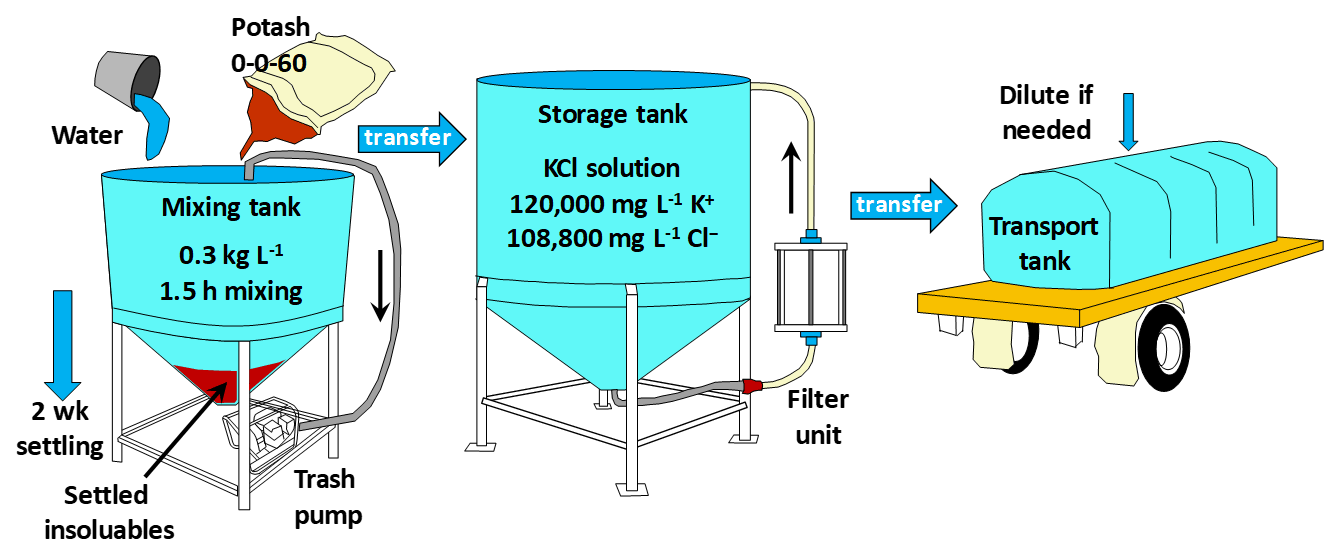
Preparation of potassium chloride stock solution for injection into irrigation pipelines.
Pipeline field study
In cooperation with the Eastern, Taber, and St. Mary River irrigation districts, Alberta Agriculture and Forestry completed five pipeline trials to develop a method to inject KCl solution into underground irrigation pipelines. The field study allowed the application and field testing of methods to obtain a target concentration of K+ for a specified period within the test pipelines.
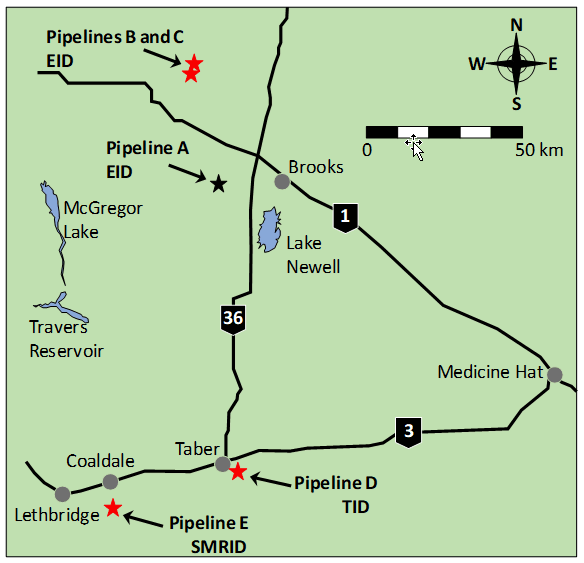
Pipeline sites in the Eastern (EID), Taber (TID), and St. Mary River (SMRID) irrigation districts.
Small-plot study
A small-plot study was carried by Alberta Agriculture and Forestry in 2016 and 2017 to investigate the effects of applying KCl-treated water on soil chemistry and crop yield and quality. The small-plot study was located at the Alberta Irrigation Technology Centre at Lethbridge, Alberta.
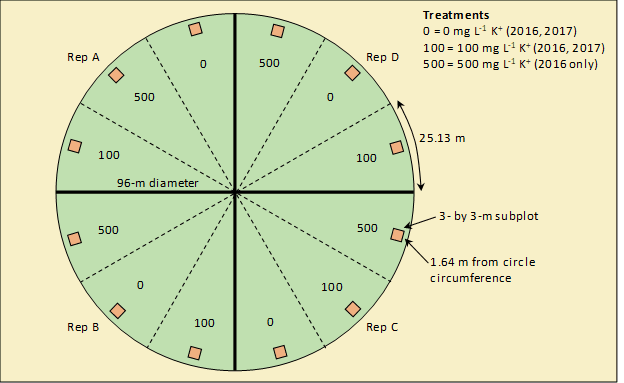
Small-plot study.
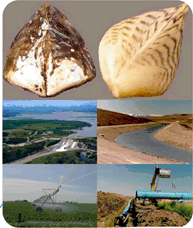 Strategic pest management plan and cost estimate study Strategic pest management plan and cost estimate study
A 10-month study was carried out to develop a strategic pest management plan and cost estimate for invasive mussels if they should become established in Alberta’s irrigation infrastructure. Under contract through the Eastern Irrigation District, the study was carried out by Paterson Earth & Water Consulting Ltd., with funding support from Alberta Innovates –– Water Innovation Program.
The study focussed on five key objectives:
- Assess the potential for dreissenid mussels to develop and grow in Alberta’s irrigation water supply reservoirs and irrigation distribution systems.
- Assess additional prevention techniques to minimize the potential for dreissenid mussels to establish in Alberta’s irrigation water supply reservoirs.
- Prepare a strategic pest management plan for the irrigation districts for a coordinated invasive mussel control program.
- Develop a range of dreissenid mussel management and treatment approaches for injecting potassium chloride into irrigation district water supply pipelines, and irrigation producer-owned water supply pipelines and on-farm irrigation systems.
- Prepare estimates of the annual operational costs associated with potassium chloride treatment approaches in the 13 irrigation districts.
Prevent the Spread!
Invasive mussels are typically transported on trailered watercraft from infested waters as attached adults or as microscopic veligers in ballast waters and bait buckets. Because several of southern Alberta’s popular boating lakes are irrigation reservoirs, the threat of an invasive mussel infestation is a concern to the irrigation industry. Prevention is the best management strategy for invasive mussels because control options are limited and costly. Everyone can work together to keep invasive mussels out of Alberta by following the clean, drain, dry rule after leaving a waterbody. The continued vigilance for invasive mussels is a key component of Alberta’s prevention program. Report any observations of invasive species to the AIS hotline 1-855-336-BOAT (2628).

Clean –– Remove any mud, vegetation, and animals from your boat, trailer, and recreational equipment before transporting it from the waterbody. Thoroughly inspect for signs of residual debris or mussels. Clean all fishing equipment including waders and boots.
Drain –– Completely drain your recreational watercraft of all water, check live wells, bilge tanks, bait containers, and engine cooling areas for water. Mussel veligers can survive in residual water, which can be transported to an un-affected waterbody. “Pull the Plug” – it’s the law!
Dry –– Allow your recreational watercraft and equipment to completely dry before use in another waterbody.
Protecting Alberta’s Irrigation Infrastructure
Alberta is the irrigation capital of Canada. The irrigated area within the province represents almost 70% of the total irrigated area in Canada. Most of the irrigated area in Alberta is within 13 irrigation districts. There are about 7900 kilometres of conveyance works and 57 water storage reservoirs. Approximately half of the conveyance system has been converted to pipelines, and more canals will be converted to pipelines in the future. The detrimental effects of mussels are a particular concern for pipelines. The value of the irrigation district infrastructure is about $3.66 billion. This figure does not include the investments of irrigators for their water supply lines and pivots, which would also be at risk with an invasive mussel infestation.
The potential implications of invasive mussel establishment in Alberta is a concern, not only for water management infrastructure, but also for recreational opportunities and the aquatic environment. Invasive mussels outcompete native species, affect water quality, and litter beaches with sharp shells. Effects are far reaching environmentally, socially, and economically.
Monitoring Programs
The Water Quality Section of Alberta Agriculture and Forestry has worked jointly with the irrigation districts and Alberta Environment and Parks to perform substrate monitoring, veliger sampling, and provide technical guidance for irrigation infrastructure monitoring.
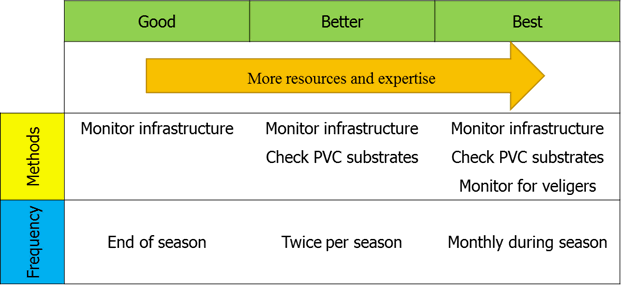
Continuum of monitoring options for invasive mussels in irrigation infrastructure.
Infrastructure monitoring
The best place to start with monitoring is to visually inspect water infrastructures during drawdown or dry periods. This monitoring permits large areas with continuous water exposure to be quickly checked, thereby making it the best approach to cover the greatest area with the shortest amount of time and resources. The irrigation districts and Alberta Environment and Parks operations staff are encouraged to inspect infrastructure at the end of the irrigation season.
PVC Substrate monitoring
Artificial substrates are annually installed in the reservoirs by irrigation district staff. Substrates are checked monthly by irrigation district staff throughout the operational season, and results are submitted to Alberta Environment and Parks.
Veliger monitoring
The Water Quality Section participated in monitoring efforts for the presence of invasive mussel veligers in southern Alberta’s irrigation reservoirs. Twenty-two irrigation reservoirs were defined as high risk for AIS introduction due to recreational boat traffic. During the past several years, Alberta Environment and Parks has included sampling for mussel veligers as part of their annual lake water quality monitoring program. However, in a given year, only a few of the 22 high-risk reservoirs are sampled. To fill this gap, Alberta Agriculture and Forestry and the irrigation districts through the Alberta Irrigation Projects Association have provided support to ensure that all 22 reservoirs are sampled annually.
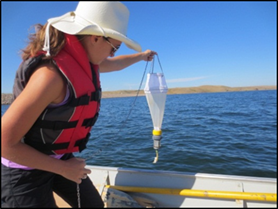
Invasive mussel veliger sampling.
For More Information
Barry Olson
Alberta Agriculture and Forestry
Lethbridge, Alberta
Toll free 310-0000
Phone: 403-381-5884
Email: barry.olson@gov.ab.ca
|
|